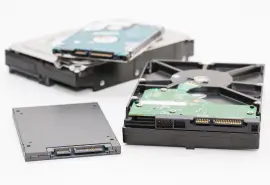All storage devices have a file system that manages data saved to its magnetic platters or memory cells. Users in the Apple ecosystem have two main options for their Macs. The default choice for modern Macs is Apple File System (APFS). However, Mac OS Extended (also known as HFS Plus) still makes sense for some users even though it is older.
Below, the experts at Secure Data Recovery, an Apple Authorized Service Provider (AASP), explain key features of APFS and Mac OS Extended. This guide will help you choose the best file system for your Mac.
Key Takeaways:
- APFS is the default file system of macOS. It has optimized performance with flash storage, enhanced security, and simpler data management.
- Mac OS Extended is a legacy file system that works on older macOS versions. It still supports features like encryption and journaling.
- You should choose APFS on computers running macOS Mojave (released September 2018) or later. Choose Mac OS Extended if you’re using an older Mac.
- A cross-platform file system like exFAT is another option for users that connect external drives to Macs and Windows PCs.
Comparing APFS and Mac OS Extended
Both APFS and Mac OS Extended have advantages and limitations. In general, modern Macs run much smoother on APFS due to its improved performance with NAND flash memory. Since 2021, all Apple desktop and laptops include solid-state drives (SSDs). In contrast, Mac OS Extended was introduced in 1998 and updated several times over the next two decades. It remains compatible with the most recent macOS releases, as well as versions that no longer receive support from Apple.
Features of APFS
Here are some of the benefits that APFS provides:
- Designed for modern storage like the SSD modules found in Macs.
- Improved performance and more efficient data handling leads to faster file operations.
- Supports multiple volumes within a single container for shared free space.
- Read-only snapshots for immutable backups to safeguard against data loss and cyber threats.
- Robust encryption methods protect sensitive data stored on the device.
These advanced features make APFS an excellent file system for both power users and casual ones.
Features of Mac OS Extended
The advantages of Mac OS Extended include:
- Compatible with the latest macOS release and legacy editions.
- Journaling keeps track of changes in the file system and preserves original data in case of logical errors.
- Simple encryption options suffice at securing private data and personal info in most cases.
- Optimized for hard disk drives (HDDs) and older hardware.
Mac OS Extended is a great choice for people who need to access files and programs on both newer and older versions of macOS.
Best File System for macOS

In short: It depends. Different users have unique requirements for their file system.
Most users should choose APFS due to its optimized performance on modern Macs. But opting for Mac OS Extended does make sense in some cases.
When To Choose APFS
APFS has the greatest benefits for most people.
APFS offers faster, reliable performance and more features than Mac OS Extended. The upgrades don’t even come at the cost of convenience. The file system functions well without substantial user input.
In addition, APFS is known for its streamlined approach to data management. It allocates space to each container as required. This design eliminates the need for manual partitioning. It also adopts a copy-on-write approach that reduces the risk of file corruption.
It provides other tools to those interested. Drives formatted to APFS are often more secure because of their encryption. APFS encodes volumes when enabled. That design prevents unauthorized parties from removing the storage device, connecting it to another computer, and extracting its data. Without login info, the encryption key will not decipher the volume.
You can also use APFS to create clones and snapshots. Clones record incremental changes to minimize file size and maximize storage space. A snapshot creates a copy of data on the device at a specific point in time. Snapshots are an effective method of transferring data to a new Mac or reverting a failed macOS update. However, these copies exist on the same drive. As a result, snapshots cannot serve as a backup unless moved to an external drive.
APFS has a pair of drawbacks, though.
- It cannot read or write data on platforms before macOS High Sierra.
- It was designed for performance with flash storage.
With that in mind, Mac users cannot realize the full potential of APFS on obsolete hardware or operating systems.
But its modern features make APFS a clear choice for most people with a newer Mac.
When To Choose Mac OS Extended
Mac OS Extended remains a solid option for some use cases despite its status as a legacy file system.
Its biggest asset is reverse compatibility. With Mac OS Extended, users can open and save files across multiple computers from several generations. This feature makes Mac OS Extended an ideal choice for those that work with different editions of macOS.
Mac OS Extended was developed when hard drives were the dominant storage device. The file system also suits Apple’s proprietary Fusion drives. The hybrid drives were included in the company’s desktops and laptops until they were discontinued in 2021.
The main reason to choose Mac OS Extended is ease of use across a wide range of Apple computers.
Best Format for Mac External Drive

The best format for a Mac external drive depends on the situation.
In general, native file systems are much better than formats that are not designed for a specific platform. That means users should choose the file system tailored toward their Mac.
Here are the best file systems for using an external drive on Mac:
- Choose APFS if you use an external SSD with a recent Mac.
- Choose Mac OS Extended if you frequently use an external hard drive on both newer and older Macs.
- Choose exFAT if you frequently use an external drive on both Mac and Windows.
Note: exFAT has a large cluster size, making it an inefficient choice for small files. It also lacks proper tooling and carries a higher risk of data loss due to a lack of journaling. Consider whether the convenience outweighs the risk when choosing a file format for a Mac external drive.
You may need to reformat your device to select your preferred file system. Most external drives use exFAT by default.
Mac Data Recovery Experts
The file system is a critical part of how smoothly your Mac runs.
Our Apple Certified Mac Technicians (ACMTs) understand the ins and outs of these file systems. There is not a universal format for all usage. You should choose the file system that best aligns with your needs. In most cases, that means choosing APFS, but there are other viable options.
If you encounter logical errors, our Mac data recovery experts can often help restore files. We have decades of experience across all Mac models, file systems, and failure types. Trust the professional service with free quotes, a 96% success rate, and a No Data, No Recovery Fee guarantee. With us, you get your data back, or pay nothing.
Call 800-388-1266 or request help to speak with a specialist and start your case.










